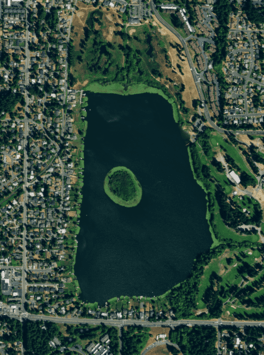Lake Ballinger facts for kids
Quick facts for kids Lake Ballinger |
|
|---|---|

Aerial image, 2017
|
|
| Location | Snohomish County, Washington, U.S. |
| Coordinates | 47°46′53″N 122°19′22″W / 47.78139°N 122.32278°W |
| Primary inflows | Hall Creek |
| Primary outflows | McAleer Creek |
| Catchment area | 3,250 acres (13.2 km2) |
| Basin countries | United States |
| Max. length | .58 mi (0.93 km) |
| Max. width | .37 mi (0.60 km) |
| Surface area | 103 acres (42 ha) |
| Average depth | 15 ft (4.6 m) |
| Max. depth | 35 ft (11 m) |
| Surface elevation | 292 ft (89 m) |
| Islands | Edmount Island |
| Settlements | Mountlake Terrace; Edmonds |
Lake Ballinger is a freshwater lake in Washington, located in southern Snohomish County. It covers about 103 acres. The cities of Mountlake Terrace and Edmonds are next to it.
Water flows into Lake Ballinger from Hall Creek at its north end. The lake's water then flows out through McAleer Creek at its east end, which eventually reaches Lake Washington.
The lake was once called McAleer Lake. This name came from Hugh McAleer, a logger who owned the lake and the land around it. In 1901, Richard A. Ballinger bought the lake. He was a very important person who later became the United States Secretary of the Interior. He renamed the lake after his father, Richard Ballinger.
Contents
What is Lake Ballinger like?
Lake Ballinger is a natural lake. It formed when a large ice sheet, called the Cordilleran Ice Sheet, melted a long time ago. The main source of water for the lake is Hall Creek. It also gets water from underground flows from nearby Echo Lake and from rain runoff.
The lake is just west of Interstate 5 in Mountlake Terrace. It is also just north of the border between Snohomish and King Counties, about three miles north of Seattle. The lake's surface is 292 feet above sea level.
Lake Ballinger has an oval shape and runs from north to south. It has a fairly straight western side. On its southeastern side, there is a wide part where water flows into McAleer Creek.
In the middle of the lake is Edmount Island. This island is about three acres and is made of peat. Houses were built on the island at two different times in the past. Today, Edmount Island is part of Ballinger Park in Mountlake Terrace. The lake is about 0.58 miles long and 0.37 miles wide at its widest point. Its deepest spot is 35 feet.
A Look at Lake Ballinger's History
Lake Ballinger was first known as Lake McAleer. This name came from Hugh McAleer, who was a logger and owned much of the land around the lake. A family named Bartholomew lived on Edmount Island starting in 1888.
In 1901, Richard A. Ballinger bought the land. He renamed the lake after his father, who was a veteran of the Civil War. Ballinger used the lake to store logs. These logs were then floated down McAleer Creek to Lake Washington for shipping. In 1914, Ballinger started selling pieces of land along the lake's western shore. He wanted to build homes there.
Improving Water Quality
In 1972, a study looked at 34 lakes in the Puget Sound area. Lake Ballinger was found to have the poorest water quality. A big problem was too much algae growing because of phosphorus pollution. This caused low oxygen levels in the lake's deeper parts.
Over the next few decades, many steps were taken to make the water cleaner:
- In 1980, special ponds were built along Hall Creek. These sedimentation ponds helped dirt and pollution settle out before reaching the lake.
- Two years later, a system was put in place to add oxygen to the bottom layers of the lake. This is called hypolimnetic aeration.
- In 1991, Mountlake Terrace was allowed to treat the water with alum. This helped reduce the amount of nutrients that caused algae to grow.
Floods and Fires
Lake Ballinger had a major flood on New Year's Day in 1997. The water rose over six feet higher than normal, which damaged several homes near the lake. During this flood, a nearby sewer line also overflowed into the lake. A similar event happened in December 2007. This flood affected three homes and caused water pollution from three different leaks.
On July 29, 2009, hot coals from a barbecue started a fire on Edmount Island. One firefighter was hurt in the fire. The peat on the island kept burning slowly for several days. The last hot spot was put out on August 9. Because of the fire, the island is still closed to visitors.
Lake Ballinger's Environment
Lake Ballinger faces several environmental challenges. Water runoff from cities brings things like oil, heavy metals, and too many nutrients into the lake.
There are also high levels of certain bacteria, called fecal coliform. This is partly because of pets and many geese in the area. To help with the geese problem, a method called egg addling is used. This stops goose eggs from hatching.
Too many nutrients in the water cause a lot of algae to grow. When this algae dies and breaks down, it uses up oxygen at the bottom of the lake. This can make it hard for fish and other creatures to live there.
Lake Ballinger is recognized as a "Priority Habitat" by the Washington Department of Fish and Wildlife. This means it is an important area for certain animals and plants.



